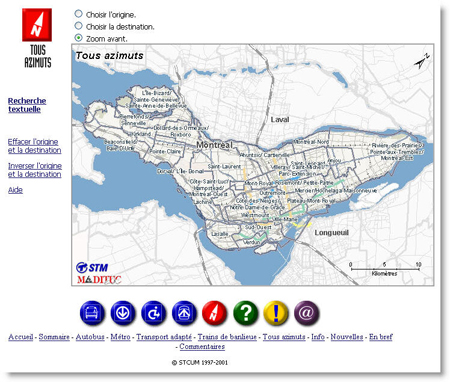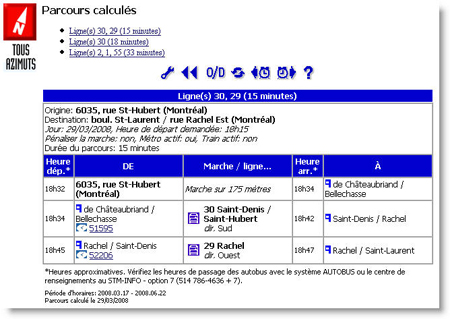The potential of a 2.0 strategy: “Tous Azimuts” the STM’s trip calculator
For those who do not know it, “Tous Azimuts” is a journey calculator available on the STM (Montreal transport company) website. By providing it with a point of origin and a destination, it sends us suggested routes, calculated according to the timetables for the different means of public transport. For those who know it, it is a tool that provides very useful but difficult to access information.
FIRST STAGE OF RESEARCH: CHOICE OF ORIGIN AND DESTINATION
SEARCH BY MAP:

This is the default search when launching the route calculation tool. The purpose of this map is to allow users to visually choose their points of origin and destination by clicking on the desired address or intersection.
The first point that penalizes this map is the lack of user guidance:
- The movement and zoom buttons only appear if the user clicks on the map for the first time (right image).
- The role of the radio buttons at the top of the page is unclear as there is no information on their use.
The second point concerns the sequence of actions necessary to use the card:
- The multiplicity of actions of a right click on the map, that is to say zoom or selection of places, obliges the user to "configure" his mouse before each step via the radio buttons at the top of the page .
- Moving on the map cannot be done by dragging it with the mouse. A destination that would take a swipe to reach requires several clicks here.
The last point concerns the fact that the interactivity standards for online maps have been implicitly imposed by major players (mapquest, google map, etc.). Even if "tous Azimuts" was launched several years before google map (1997-2001 versus 2005 for google map canada) the fact of not respecting these standards imposes an additional workload on users.
TEXT SEARCH:
This mode of research has two main strengths:
- The multiplicity of search options which makes it possible to respond to the main operating modes of users,
- The effectiveness of the sequence of actions that allows you to achieve results quickly.
Its weak points are:
- Input errors are not supported by an alternative spelling proposal. the error messages are sometimes imprecise: “intersection not found”.
- A certain lack of clarity of information in the choice of metro or train stations which are grouped together in the same drop-down menu.
- The search engine's guidance by important places can confuse users by stating “…Avoid qualifiers. For example, for place Ville-Marie, enter Ville-Marie only” while the two queries (“place ville marie” and “ville marie”) return the same results.
SECOND STAGE OF THE RESEARCH: CONFIGURATION OF THE COURSE
I will not dwell on this step which does not seem to present any major problems. Let's just say that it allows you to choose different options such as the time of departure or arrival, or even the use of walking. The form is relatively clear and the default choices for the different fields are sensible.
LAST STEP OF THE RESEARCH: PRESENTATION OF THE RESULTS

Although allowing users to achieve their goal rather well, this last step could still be improved:
- The icons above the courses are relatively unclear, especially since the "alt" fields of the images are not filled in.
- The presentation of each route is quite busy, in particular with the repetition for each result of the route entered by the user.
- Note also that it is not possible to easily modify the initial search from this screen.
THE POTENTIAL OF A 2.0 STRATEGY:
With current technology this tool could easily be improved to become a real web 2.0 tool:
- The simple addition of the possibility of saving itineraries would represent a significant time saving for regular users and would be an effective loyalty tool.
- Emailing directions would also be a nice feature.
- As we can't talk about web2.0 without talking about social networks, let's just imagine a facebook application that would allow you to add routes when you create an event. This could prove beneficial for the organizer, by facilitating access to the event site, but also for the STM by increasing its visibility.
- The possibility of taking a route with either during its journey would also be very interesting, either by printing it or, in a more modern way, by exporting it to a mobile unit.
Finally, beyond the "Tous azimuts" tool, it is the complete web strategy of the STM site that would benefit from a "facelift", especially if we compare it with similar sites such as ratp.fr (Paris ), tcl.fr (Lyon), mbta.com (Boston). Even a brief analysis could easily define actions for:
- Increase the number of visits to the site,
- Improve the effectiveness of public relations campaigns,
- Respond more effectively to the growing expectations of Internet users,
These actions would build on, and support, the socio-economic trend that is driving people to increasingly seek alternatives to the car. By exaggerating slightly, we could even go so far as to say that the redesign of the site would be beneficial for the environment, by helping to increase the number of users of public transport.
-2.png)






